Comparing the 2020 COVID-19 and 2003 SARS Pandemics
By Ward J. Atkinson, MACS Technical Advisor
When COVID-19 first appeared in the news, the U.S. general population wasn’t very concerned. Many assumed that like the SARS pandemic, it would only affect relatively few people.
The 2002–2003 SARS outbreak lasted about eight months. The World Health Organization declared that SARS was contained on 5 July 2003. During that time period, over 8,000 people were infected, and at least 774 died in 29 different countries and territories worldwide.
The COVID-19 has proven to be much more severe and it’s not over yet. This virus raises serious questions about the best way to clean a vehicle prior to service (protecting the service technician) and the best way to clean it after service (to protect the customer).
The coronavirus that causes COVID-19 mainly spreads from person to person. When someone who is infected coughs or sneezes, they send droplets containing the virus into the air. These droplets can also be expelled when laughing or talking loudly in a crowded area when being close to others. You may also catch the virus if you touch a surface or object that has the virus on it and then touch your mouth, nose, or eyes.
Current evidence suggests that SARS-CoV-2 may remain viable for hours to days on surfaces made from a variety of materials. With different kinds of hard surfaces (such as metal, doorknobs, jewelry, silverware, drinking glasses, mirrors, and windows), the virus may last for up to 5 days. With plastic surfaces (such as milk containers, detergent bottles, vehicle interior, backpacks, elevator buttons), the virus may last up to 2 to 3 days.
Transmission of the virus through the ventilation and filtration systems, while possible, is less likely.
To reduce your chance of catching or spreading the new coronavirus, wear a mask to reduce possible person-to-person transmission and clean and disinfect common surfaces and objects at least every day.
Due to the complexity of the COVID-19 subject, the best approach is that the service technician needs to take all the precautions that they are comfortable to protect themselves when working on the vehicle.
Coronavirus and Temperature
Coronaviruses generally don’t live as long in higher temperatures and humidity levels as compared to cooler, dryer conditions. Researchers are studying exposure to heat, cold, or sunlight and how long the new virus lives on surfaces.
SARS was proven to be killed at 56°C (132.8°F) in 15 minutes according to the WHO (World Health Organization).
The coronavirus can live for hours to days on surfaces. How long it survives also depends on the material the surface is made from. At this time there is no factual information on the required temperature and conditions required to kill SARS-CoV-2 on the various cabin material surfaces.
The family of viruses that includes the one that causes COVID-19 can live on some of the surfaces you probably touch every day.
*Researchers still have a lot to learn about the new coronavirus. But you’re probably more likely to catch it from being around someone who has it than from touching a contaminated surface. Refrence: https://www.webmd.com/lung/how-long-covid-19-lives-on-surfaces
The U.S. EPA provides the following guidelines (coronavirus.gov)
6 Steps for Safe & Effective Disinfectant Use
Step 1: Check that your product is EPA-approved. Find the EPA registration number on the product. Then, check to see if it is on EPA’s list of approved disinfectants at: https://www.epa.gov/pesticide-registration/list-n-disinfectants-use-against-sars-cov-2-covid-19
Step 2: Read the directions. Follow the product’s directions. Check “use sites” and “surface types” to see where you can use the product. Read the “precautionary statements.”
Step 3: Pre-clean the surface. Make sure to wash the surface with soap and water if the directions mention pre-cleaning or if the surface is visibly dirty.
Step 4: Follow the contact time. You can find the contact time in the directions. The surface should remain wet the whole time to ensure the product is effective.
Step 5: Wear gloves and wash your hands. For disposable gloves, discard them after each cleaning. For reusable gloves, dedicate a pair to disinfecting for COVID-19. Wash your hands after removing the gloves.
Step 6: Lock it up. Keep lids tightly closed and store out of reach of children.
List N from the EPA: Disinfectants for Use Against SARS-CoV-2
All products on the list meet EPA’s criteria for use against SARS-CoV-2, the virus that causes COVID-19.
The product container must have the EPA registration number and that human coronavirus is listed as a target pathogen.
These products are to be used only on hard nonporous surfaces.
Note: Inclusion on this list does not constitute an endorsement by EPA. Additional disinfectants may meet the criteria for use against SARS-CoV-2. EPA will update this list with additional products as needed.
Product Label: The companies list their product range and basic chemicals (active ingredients) used in the products.
The Current EPA List N: as of July 1, 2020 has over 430 products entries.
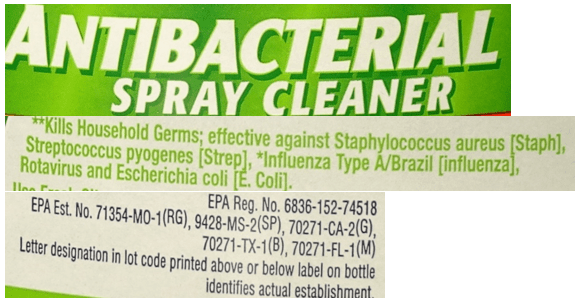
Other Disinfecting Processes
Other disinfecting processes have been discussed that may have limitations and personnel safety concerns.
Infrared: May not be able to reach all vehicle surfaces for disinfecting. Proper use instructions must be followed for all approved sources.
Ozone generated air cleaners: Some studies show that ozone concentrations produced by ozone generators can exceed health standards even when one follows the manufacturer’s instructions. Many factors affect ozone concentrations including the amount of ozone produced by the machine(s), the size of the indoor space, the amount of material in the room with which ozone reacts, the outdoor ozone concentration, and the amount of ventilation. It is difficult to control the ozone concentration in all circumstances. Reference: https://www.epa.gov/indoor-air-quality-iaq/ozone-generators-are-sold-air-cleaners
Use of High Temperature for Disinfecting
In general it is difficult to raise, in a closed vehicle, all cabin material surface temperatures to at or above 133°F (which is the temperature that has been shown to kill SARS virus by the WHO) using sun soak or sun and supplemental heat from the vehicle heater.
Coronaviruses generally don’t live as long in higher temperatures and humidity levels than in cooler, dryer conditions. Researchers are studying exposure to heat, cold, or sunlight and how long the new virus lives on surfaces.
There have been various proposals of using solar and/or vehicle heaters to increase interior cabin surfaces in temperature.
Solar and vehicle heating: Solar heating is limited to only warming surfaces in direct sun to high temperatures. Solar heating (radiation intensity) is affected by location and weather conditions within the US area.
Use of vehicle soak procedures by raising the vehicle interior temperature cabin surfaces have many issues: Vehicle cabin temperature can be increased using the vehicle heater. It is difficult to raise all cabin surfaces to same or potential required temperature to kill the virus. Use of solar and/or vehicle heater to raise cabin surface temperatures is not practicable to kill the virus.
Vehicle Test Results
The test results of these procedures of heating a passenger car cabin compare heating and solar is found below in Figures 2 to 7 and Charts 1 and 2. Eight cabin temperatures were recorded during a 78°F to 82°F day. It is important to note that the vehicle had a rear seat A/C outlet, which affected rear seat surface and floor temperatures when the vehicle heater mode was used.
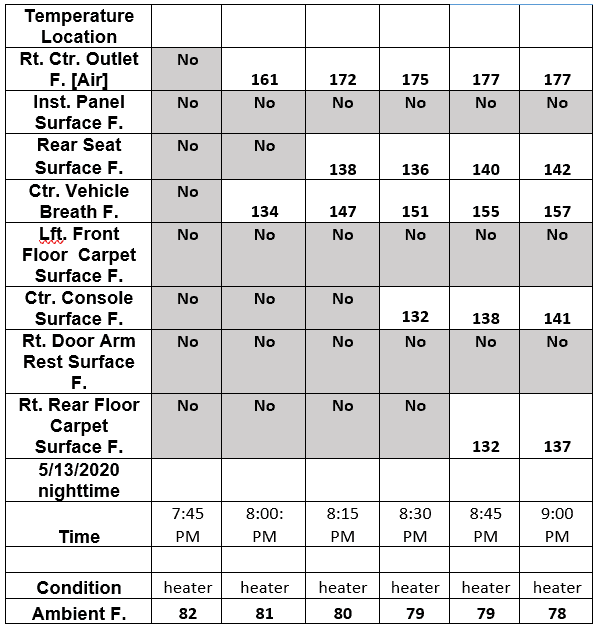
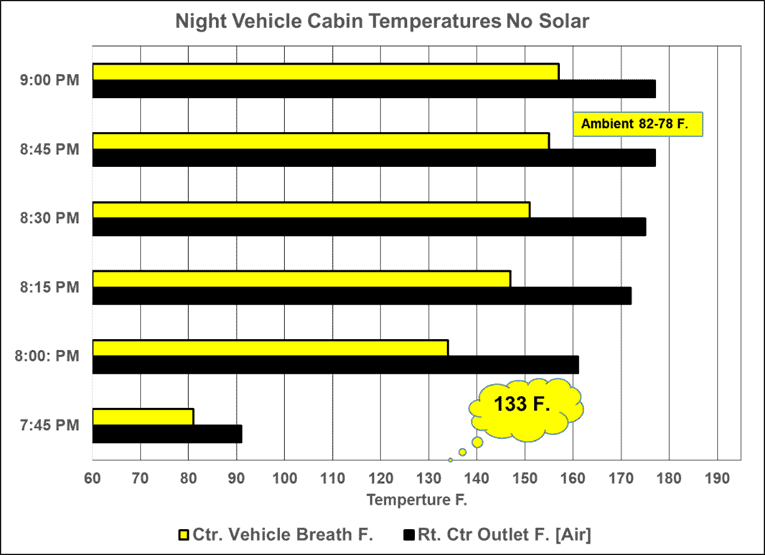
* Note the 133°F marker on each graph.
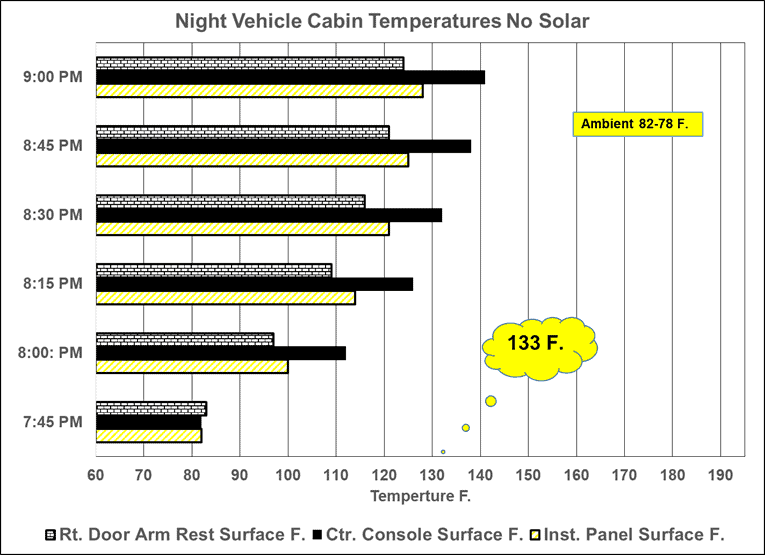
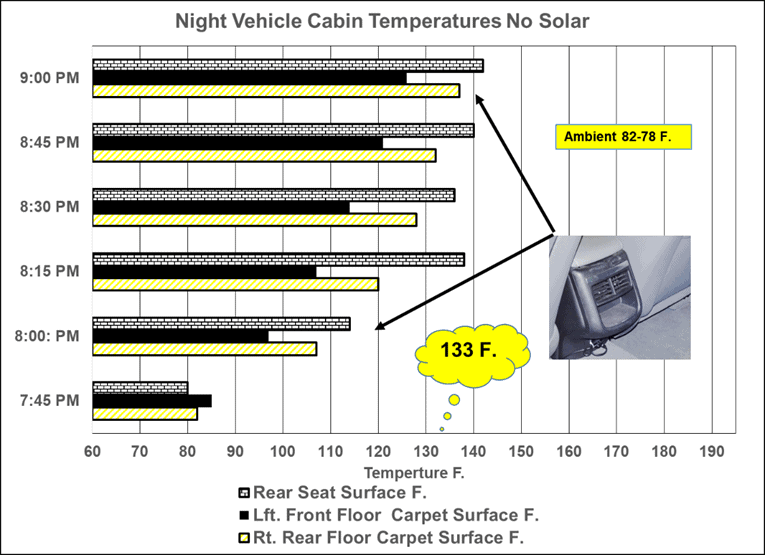
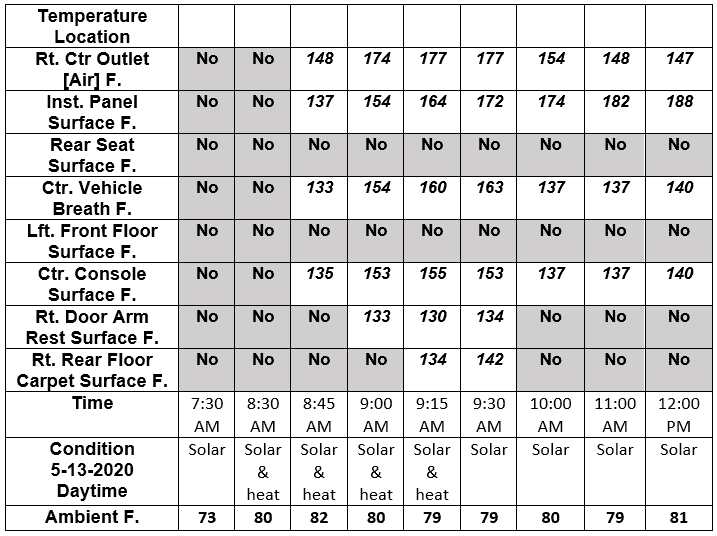
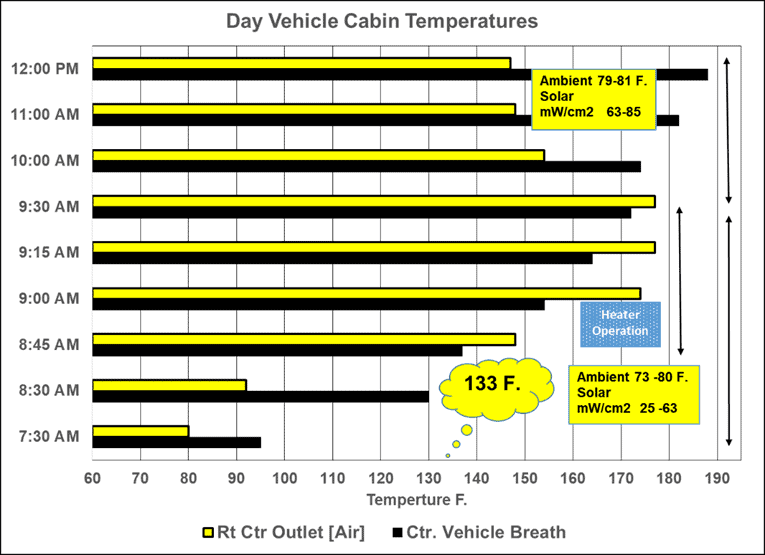
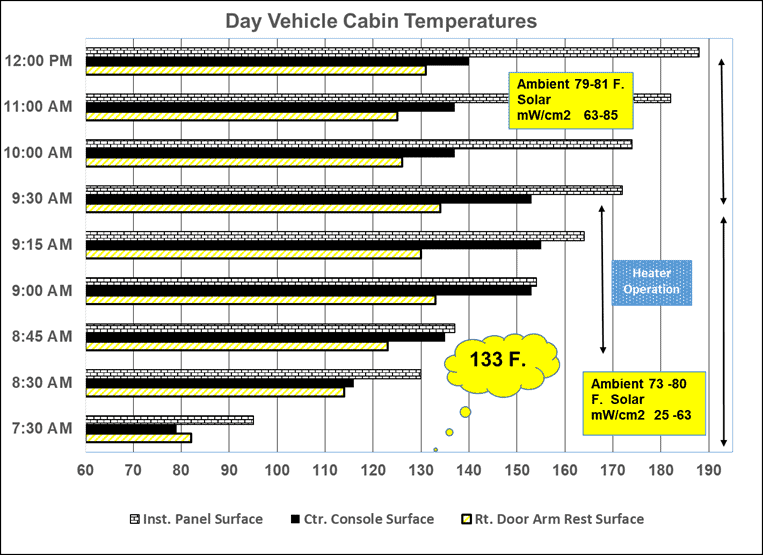
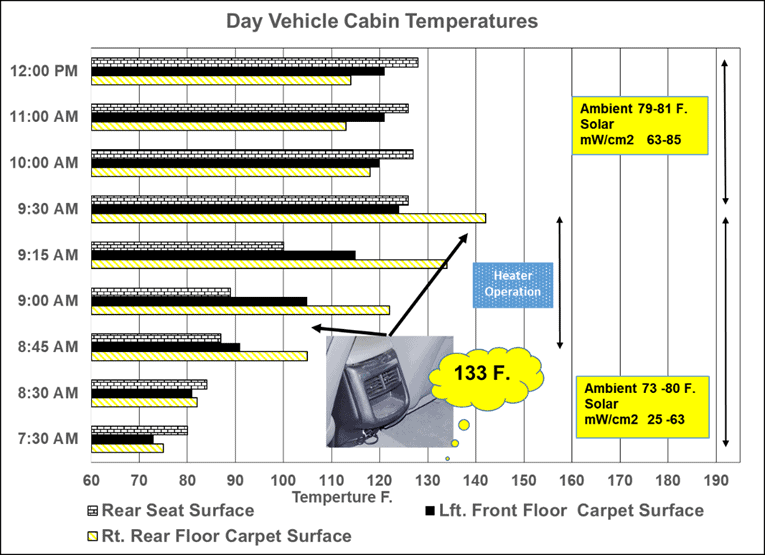
Heater operation set for maximum temperature heat mode, airflow set for instrument panel A/C outlet air distribution. Vehicle equipped with automatic temperature control having rear seat A/C air outlet.
Automotive Service Concerns
The folloing excerpts are from an April 2020 letter the Mobile Air Conditioning Society (MACS) sent to U.S. regulatory agencies:
It is estimated in 2020 there are 287.3 million vehicles operating on roads throughout the United States. These vehicles are operated by more than 227.8 million motorists, serviced by 763,700 auto service technicians and mechanics at 166,000 different automotive service facilities in the USA, all needing protection from the coronavirus.
Each vehicle cabin is a small, self-contained, climate-controlled environment, which restricts movement, requires close contact of occupants, and repeated touching of interior surfaces.
Air conditioning panel outlets are close to occupants’ faces, directing air at the occupants face, mouth and nose.
The instrument panel surface can become contaminated by breathing/coughing of front seat occupants. Panel A/C outlets airflow will pull air from the panel surface, mixing it and delivering it toward the cabin interior.
The climate control system in vehicles present different challenges, as compared to a residential environment. Operation of the system allows the selection of 100% exterior (outside air) and cabin recirculated air. In the recirculated mode, system A/C designs for the amount of outside airflow can vary. The number of air exchanges per hour may be less than many household applications. Typical industry requirements, for a home, are in the range of 4 to 6 air exchanges per hour. Some mobile A/C systems operating in the MAX cooling mode (recirculated air) have provided at least 6 exchanges per hour.
The velocity of airflow directed onto the occupants is usually much higher than in residential systems.
There are a large variety of filters in some mobile A/C systems that require servicing and some vehicles have no air filter.
There is also concern for cleaning vehicles after the vehicle has been entered by others, for oil changes, for maintenance activities or valet parking.
Cleaning Procedures and Chemicals
The following is a collection of COVID-19 information on cleaning vehicles that is available to the public from different sources.
It is notable that references are made.
- “Consult the cleaning information provided by the vehicle manufacturer”
- Caution on using full strength bleach or hydrogen peroxide. They can kill coronaviruses on surfaces, but may damage upholstery and interior trim.
- Some general information listed have been suggested since March 2020.
- New information and products may provide information and procedures for sanitizing vehicles and should be considered for vehicle cleaning.
- Alcohol solutions that contain at least 70% alcohol are effective against coronavirus, according to the CDC.
- Never combine cleaning chemicals as doing so may lead to toxicity.
- Testing an out of sight surface with the selected cleaning agent is advisable in case of possible damage.
- Cleaning with a microfiber cloth materials may help remove dirt from surfaces.
One major supplier of automotive interior parts, indicate that their company’s products, “from plastic trim to painted chrome to imitation leather, have been tested to ensure they don’t degrade when exposed to pure isopropyl alcohol.”
Do not use ammonia-based cleaners on car touch screens, as they can damage their anti-glare and anti-fingerprint coatings.
“Friction from cleaning also participates in the destruction,” says Stephen Thomas, M.D., chief of infectious diseases and director of global health at Upstate Medical University in Syracuse. “You want to do the best with what you have, so even soap and water can chip away at the risk.”
Soap and water are safe for most car interiors including fabrics and older leather that may have begun to crack. Excess amounts of cleaning solutions, such as water and soap can result in soaking through the cloth surface into the seating material and the potential of future odor problems.
Vehicle High Touch Areas:
- Car keys and fobs
- Door handles and lock buttons
- Steering wheel
- Shift lever
- Wiper and turn signal levers
- Controls for touch screen accessory controls
- Center console contents
- Armrests
- Seat belts
- Headrest
- Seat pockets
- Handles
- Seat adjusters
Wash your hands before and after driving
When outside the vehicle wear gloves. Contact of high traffic surfaces that are not disinfected, when opening and closing doors, keypads, signing charge card pads and fuel nozzle handle when pumping gas.
About MACS Worldwide
Founded in 1981, MACS is the leading non-profit trade association for total vehicle climate and thermal management. Since 1991, MACS has assisted more than 1 million service technicians to comply with the 1990 U.S. EPA Clean Air Act requirements for Section 609 certification in refrigerant recovery and recycling to protect the environment. The Mobile Air Conditioning Society (MACS) Worldwide’s mission is clear and focused–as the recognized global authority on mobile air conditioning and heat transfer industry issues.
It is a mission we have been fulfilling for our growing global membership and the industry in the following ways:
Providing accurate, unbiased technical training, and compliance programs for the mobile air conditioning and heat transfer industry.
Providing a forum for exchange of trade information on a regional, national and international basis.
Facilitating business between all segments of the industry.
Providing tangible value for members, such as product marketing, promotion and money-saving affinity programs.
Disseminating legislative, regulatory and trade information (including data, current developments and training materials).
Providing information on legislative and regulatory initiatives that affect the industry and advocate for the industry to legislative bodies.
Visit our website www.macsw.org for more information or call (215) 631-7020.
And as always, Thanks for Reading!
Edited by: Steve Schaeber, MACS Technical Editor on 7/13/2020

Leave a Reply